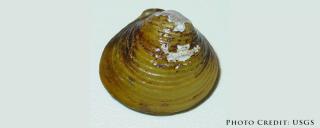| Scientific Name |
(Corbicula fluminea) |
| Classification and Permitting Level |
1 - Prohibited Aquatic Nuisance Species |
| Species Description |
A golden clam is an invasive freshwater clam that is less than 2 inches in length. The size and distinctive coarse rings on the shell distinguish this species from native clams. |
| Preferred Habitat |
Live golden clams are typically buried in up to 6 inches of sand or gravel, though shells can often be found on the sediment surface. |
| Reason for ANS Designation |
Although there may be some impact by this clam through its filter-feeding of small plants and animals, the most significant impacts come from fouling water pipes in power and water industries. Once established, there is no good control method. |
| Place of Origin |
golden clams are native to southern Asia but were introduced to the United States in the 1930s. It was likely originally imported as a food item or as a contaminant in oyster shipments. More recent introductions and spread are likely from the movement of water or vegetation carrying juvenile clams. |
| Stopping the Spread |
When taking equipment out of a lake or stream, remove all plants and mud and drain all water prior to leaving. Allow the equipment to dry completely, rinse with 140°F water for 10 seconds of contact, or disinfect using an approved method such as a .02% bleach solution for 10 minutes of contact time or freezing for 72 hours. |
| Additional Information |
USGS Fact Sheet |

